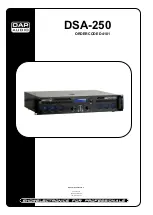
8
Operation
Installation
Remove all packing materials from the DSA. Check that all foam and plastic padding is removed.
Secure the equipment into a 19" rack. Connect all cables.
Connecting Power /
Circuit Size Requirements.
DSA Series amplifier power requirements are rated at:
a)"idle"
b) 1/8th
power ("typical" music conditions)
c) 1/3rd power ("continuous" music conditions)
d.] maximum rated power (circuit breaker limited).
The maximum power current draw rating Is limited only by the front panel circuit breaker. Consult the
specification In the
Appendices
section for figures on the current that each amplifier will demand.
Make sure the mains voltage Is correct and Is the same as that printed on the rear of the amplifier.
Damage caused by connecting the amplifier to Improper AC voltage Is not covered by any warranty.
Unless otherwise specified when ordered. DAP audio amplifiers shipped to customers are configured as
follows:
North America 120VAC/60Hz
Europe 230VAC/50Hz
Asia 220VAC /50Hz/60Hz
Australia 240VAC/50Hz
South America 120VAC/60Hz or 220VAC/50Hz
Japan 1OOVAC/50Hz
NOTE:
Always turn off and disconnect the amplifier from mains voltage before making audio
connections.
Also, as an extra precaution, have the attenuators turned down during power
-up.
Cooling System and Requirements.
DSA Series amplifiers use a twin-tunnel forced-air cooling system to maintain a low, even operating
temperature. Drawn In by dual fans on the rear panel, air flows through the cooling fans of the channel
heat sinks (dissipating power transistor heat), then exhausts through the front panel slots. The "Intelligent"
variable-speed DC fans are controlled by heat sink temperature sensing circuits. When the amplifier Is
turned on, the fans briefly "rev up," then slow to an Idle; this Indicates that the temperature sensing circuits
are operating normally. The fan speed Increases only as required by heat sink temperatures, keeping fan
noise to a minimum. Under extreme thermal load, the fans will force a very large volume of air through
the heat sinks. If either heat sink surpasses the maximum allowed temperature, the sensing circuit will
open the output relay, disconnecting the load from that channel. If the power transformer overheats,
another sensing circuit opens both channel output relays until the transformer cools to a safe
temperature.
IMPORTANT: To ensure optimum cooling, periodically clean the amplifier fan filters (removable
without tools). Also make certain that there
is
enough space around the front of the amplifier to allow
the cooling air to escape
.
If the amplifier is rack-mounted, do not use doors
or
covers on the front of
the rack; the exhaust air must flow out without resistance. If the amplifiers are housed in racks
with closed backs, allow at least one (1)
standard rack space of opening In the front of the rack for
every four amplifiers.
Connecting Inputs.
Use either the XLR or 1/4
-inch
input connectors on the rear to supply audio signals to your DAP Audio
Series amplifier. Both connectors accept balanced and unbalanced audio connections. (The
DSA Series amplifiers are configured standard with "Pin 2 hot" on XLR inputs. The unused connector can
be used to loop the audio Input to another amplifier Input. For more Information, see the section on
Balanced 1/4" (TRS) & XLR Input Connector, Input XLR Polarity.
Connecting Outputs.
Speakers are connected using Speakon connectors. For More information, see Page 9.





































